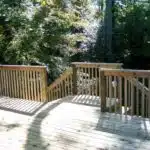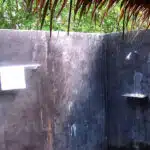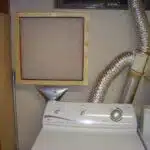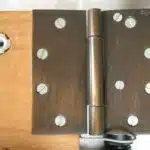As a deck installation expert, I have come across many homeowners who want to enhance the look of their outdoor living space by installing lattice under their deck. Lattice is a decorative panel that can be used to hide unsightly areas under your deck while also providing ventilation. It can also be used as a privacy screen or to create an outdoor room. However, installing lattice can be a daunting task for those who are not familiar with carpentry or DIY projects.
In this article, we will provide step-by-step instructions on how to install lattice under your deck. We will cover everything from measuring and preparing the area to cutting and installing the lattice panels. By following these instructions, you will be able to add a beautiful and functional element to your outdoor living space while also increasing the value of your home. So, let’s get started!
Tools And Materials Needed
When it comes to installing lattice under a deck, it is important to have the right tools and materials on hand. Choosing appropriate materials is crucial to ensure that the project lasts a long time without needing constant repairs or maintenance. For example, pressure-treated wood or vinyl lattice panels are popular choices because they are durable and resistant to moisture damage.
Safety considerations during installation should also be taken into account. Always wear protective gear such as gloves and eye goggles when handling sharp tools or working with power tools. It is also essential to have a stable work surface and sturdy scaffolding or ladders when working at heights.
Another important safety consideration is ensuring that the area underneath the deck is clear of any debris or obstacles before beginning work. This will prevent any accidents or injuries that may occur from slipping or tripping over objects in the workspace. By taking these safety precautions, you can minimize risks and ensure a successful installation process.
With the right tools and materials on hand, as well as proper safety precautions in place, you can begin measuring the area for your lattice installation.
Measuring The Area
After gathering the necessary tools and materials, the next step is to measure the area where you want to install the lattice. Using precise measuring techniques is crucial in ensuring that you have accurate measurements of the space. Start by measuring the length and width of your deck. If your deck has an irregular shape, divide it into smaller sections and measure each section separately. Once you have all the measurements, add them together to get the total length and width.
Calculating the required lattice material is essential to ensure that you purchase enough material for your project. To determine how much lattice material you need, first calculate the square footage of your deck by multiplying its length and width. Next, decide on your desired spacing between slats; the standard spacing is 1 ¾ inches but can vary based on personal preference. Divide your chosen spacing by 12 to convert it to feet, then multiply this number by the total square footage of your deck. This calculation will give you an estimate of how much lattice material you need.
Measuring accurately and calculating required materials will save time and money in the long run. Having too much or too little lattice material can cause delays in completing your project or require additional trips to purchase more material. Take extra time during this step to ensure that all measurements are precise before moving on to preparing the ground for installation.
Emotive Numeric List:
- Accurate measurements lead to a successful project outcome.
- Precise calculations prevent unnecessary expenses.
- Investing time in measuring ensures a smooth installation process.
Now that we have accurate measurements and calculated our required materials let’s move forward with preparing the ground for installation without delay!
Preparing The Ground
Ground preparation is a crucial part of any deck installation project, and it is particularly important when installing lattice under the deck. The first step in ground preparation is to ensure that the area where the lattice will be installed is free from any obstacles such as rocks, tree roots, or debris. These items can interfere with the leveling process and make it difficult to achieve a smooth surface.
Once the area has been cleared, you will need to use various leveling techniques to create a level surface. One effective technique is to use a long piece of wood or metal and lay it across the ground. This tool will help you identify high and low spots in the ground. You can then add or remove soil to create a level surface. It’s important to take your time during this process because an uneven surface can cause problems later on when you are building the frame.
Another helpful technique for leveling the ground is using a laser level. This tool projects a beam of light that can help you identify high and low spots in the ground quickly. Laser levels are particularly useful if you are working on a large area because they save time and effort compared to using traditional leveling methods. Whatever method you choose, make sure that you take care during this step because having a flat surface will make your job easier in subsequent steps.
As soon as you have created a smooth, even surface for your lattice project, you can move on to building the frame that will support it. Before doing so, however, be sure that all preparations have been completed and there are no obstructions left in the way that could compromise your progress at this stage of development.
Building The Frame
After the ground has been prepared, it’s time to start building the frame for your lattice. The first step is to choose the types of lumber you want to use. Pressure-treated wood is an excellent choice because it is durable and can withstand harsh weather conditions. You can also use cedar or redwood for a more natural look. Once you have decided on the type of lumber, measure and cut the boards to fit around the perimeter of your deck.
When building the frame for your lattice, spacing between frame boards is crucial. A gap that is too wide may cause the lattice panels to sag over time, while a gap that is too narrow may not allow enough air circulation underneath your deck. A good rule of thumb is to space your frame boards no more than 16 inches apart. This spacing will provide adequate support for your lattice panels and ensure proper ventilation.
Before moving on to cutting the lattice panels, make sure that your frame is level and secure. Use screws or nails to attach each board securely to the deck’s joists or beams. Once you have finished securing all of the boards in place, it’s time to move on to cutting the lattice panels.
List:
- Choose pressure-treated wood or cedar/redwood for durability.
- Measure and cut boards accurately.
- Space frame boards no more than 16 inches apart.
- Secure each board with screws or nails before cutting lattice panels.
Cutting The Lattice Panels
Once you have measured and marked the lattice panels, it is time to cut them. Cutting lattice panels can be a challenging task, but with the right cutting techniques and safety precautions, it can be done with ease. There are several cutting techniques you can use for lattice panels, including using a circular saw or a jigsaw.
When using a circular saw to cut lattice panels, it is important to use a fine-toothed blade to prevent the panel from splitting or cracking. Place the panel on a flat surface and secure it with clamps or weights to prevent it from moving during cutting. Use your measuring tape and pencil to mark your cut lines precisely on both sides of the panel before making your cuts with the circular saw.
Alternatively, you can use a jigsaw to cut lattice panels, which is especially useful when making intricate cuts or curves. Remember to wear safety glasses and ear protection when using power tools like these. Secure the panel firmly in place before starting your cuts and follow your marked lines carefully. By following these cutting techniques and safety precautions, you’ll be able to create precise cuts for your lattice underdeck installation.
In the next section, we will discuss painting or staining the lattice after installation. Before that, however, ensure that all of your cuts are clean and free of any jagged edges or splinters. Remember that safety comes first when working with power tools like circular saws and jigsaws – always wear protective gear and follow manufacturer’s instructions for proper usage. With these tips in mind, you’ll be able to complete this step of installing lattice under a deck easily and safely.
Painting Or Staining The Lattice
After cutting the lattice panels to size, it’s time to install them under your deck. The first step is to choose the right paint or stain for your lattice. If you’re looking to highlight the natural wood grain of your lattice, staining is the way to go. Stain penetrates deep into the wood and provides long-lasting protection against moisture and sun damage. On the other hand, if you want a wider range of color options and a more opaque finish, painting may be a better choice.
One of the benefits of staining over painting is that it requires less maintenance in the long run. While painted lattice may need touching up every few years due to chips and peeling, stained lattice typically only needs reapplication every 3-5 years. Plus, if you live in an area with harsh weather conditions like extreme heat or cold, staining can provide an extra layer of protection against these elements.
Once you’ve chosen your paint or stain, it’s time to apply it to your lattice panels before attaching them to the frame. Be sure to follow manufacturer instructions for application and drying times. After your panels are dry, use screws or nails to attach them securely to the frame. It’s important not to attach them too tightly as this can cause warping over time. With proper installation, your lattice will provide both aesthetic appeal and functional benefits like increased privacy and shade for years to come.
Attaching The Lattice To The Frame
- When attaching lattice to a frame, it is important to measure and mark out where the holes need to be drilled.
- Drill holes in the frame and lattice pieces, ensuring they are in line with each other and that the distance between them is equal.
- Make sure the holes are bigger than the screws so they can be easily inserted.
- Use a countersink bit to create a recess for the screw head, which will make the screws sit flush with the surface.
Marking Out
Design options for lattice under a deck are varied, but one important step is marking out the attachment points. Begin by measuring the length and height of the deck’s perimeter where the lattice will be attached. This allows you to determine how much material you need and ensures that the installation will be level and flush with the existing structure. Marking out also gives you an opportunity to consider design options, such as spacing between lattice panels or creating decorative patterns.
The benefits of installing lattice under a deck cannot be overstated. It provides an attractive way to conceal unsightly storage areas while still allowing ventilation. Lattice also serves as a barrier to prevent small animals from accessing these spaces or making nests underneath your deck. Properly installed, it can enhance curb appeal and potentially increase property value.
When marking out attachment points for lattice under a deck, remember to take into account any potential obstacles such as landscaping features or uneven ground. Consider using stakes and string to create straight lines and level planes before digging post holes or beginning installation. And don’t forget to double-check all measurements before making any cuts or attaching materials. By taking care during this important step, you’ll ensure that your lattice installation is not only functional but also visually appealing.
Drilling Holes
Now that the attachment points for lattice under the deck have been marked out, it’s time to move on to attaching the lattice to the frame. One important step in this process is drilling holes for screws or bolts. There are several types of drills that can be used for this task, including cordless drills, hammer drills, and rotary hammers. Cordless drills are convenient and portable, while hammer drills and rotary hammers offer more power for drilling through tough materials like concrete.
When drilling holes for lattice installation, safety should always be a top priority. Eye protection is essential to prevent debris from flying into your eyes during drilling. Additionally, make sure to wear gloves and long sleeves to protect your skin from sharp edges or metal burrs. It’s also important to make sure your drill bits are properly secured in the chuck before beginning any drilling.
Before starting to drill holes for lattice installation, it’s important to double-check all measurements and ensure that the frame is level and plumb. Once you’re ready to begin, use a pencil or marker to mark where each hole will go. Then, carefully drill each hole using a steady hand and consistent pressure. With proper preparation and attention to detail during the drilling process, attaching lattice under your deck can be a safe and straightforward project that adds both functionality and aesthetic appeal.
Creating A Door Or Access Panel
As the saying goes, “a door is not just a door.” When it comes to creating a door or access panel for your lattice under deck project, it’s important to choose the right hardware. While hinges and latches may seem like small details, they can make a big difference in the functionality and aesthetic of your access panel.
First, consider what type of door or access panel you want to create. A hinged door that swings open on one side is a common choice, but sliding doors or panels that lift up can also work well depending on your space and needs. Once you’ve decided on the type of door, choose hardware that is both sturdy and visually appealing. Stainless steel hinges and latches are a popular option for their durability and sleek look.
When installing your hardware, be sure to follow manufacturer instructions carefully. Use appropriate tools for the job and take extra care when drilling into your deck or support beams. Proper installation will ensure that your access panel functions smoothly and securely. With the right hardware in place, you’ll have easy access to the area beneath your deck while maintaining a polished look.
Transition: Now that you have created an access point for your lattice under deck project, it’s time to secure the lattice panels themselves.
Securing The Lattice Panels
Now that the lattice panels have been properly installed, it is time to focus on securing them. This step is crucial in ensuring that the panels remain intact and do not shift or move over time. There are several types of fasteners that can be used to secure lattice panels, including screws, nails, and staples. It is important to choose the right type of fastener based on the material of your deck and the type of lattice panel being used.
When securing lattice panels, it is also important to consider the spacing between them. The ideal distance between each panel will depend on your personal preference as well as local building codes. Typically, a spacing of around 1 inch or less is recommended for privacy reasons. However, it is important to ensure that there is enough space for air circulation under the deck in order to prevent moisture buildup and potential damage.
Properly securing lattice panels can be a tedious process but it is essential in ensuring a long-lasting installation. Take your time when selecting appropriate fasteners and spacing between panels to avoid any issues down the line. Once you have secured all of your lattice panels, you can move on to adding trim and finishing touches for a polished final look.
Adding Trim And Finishing Touches
To truly complete the look of your deck, adding trim and finishing touches is essential. This step will not only enhance the visual appeal of your structure but also protect it from harsh weather conditions. When considering trim options, it’s important to think about the overall design of your deck and how you want it to look. Whether you prefer a classic or contemporary style, there are numerous ways to customize your deck.
One of the most popular decorative options for deck trim is lattice work. Lattice panels can be installed around the perimeter of the deck or used as a skirting for added privacy. Painting techniques can be utilized to further enhance its appearance or match it with the rest of your deck’s color scheme. For instance, use two contrasting colors on different sides of the lattice panel to create a striking contrast, or apply a single hue that complements your home’s exterior.
When installing lattice work for your deck trim, keep in mind that there are various styles available to choose from. Some people opt for wooden lattice panels that add warmth and texture to their outdoor space while others prefer vinyl panels that require less maintenance and can withstand harsh weather conditions. Regardless of which option you choose, make sure to measure accurately before installing and use appropriate tools like a saw and drill. With patience and attention to detail, you can easily achieve a professional-looking finish that will elevate the overall aesthetic appeal of your deck.
As you near completion on this project, it’s time to start thinking about installing a skirt around your deck. This addition is not only visually appealing but also serves practical purposes such as keeping unwanted pests out from under your structure while improving curb appeal. In our next section, we’ll go over some tips on how to install a skirt properly so that you can enjoy all its benefits without any hassle.
Installing A Skirt
When installing a skirt for your deck, there are different designs to choose from. The most common design is the lattice style, which offers a visually appealing look while also providing a functional purpose of hiding the space below your deck. Other designs include solid panels or slats that can be customized to match the overall aesthetic of your deck.
One cost-effective material for lattice installation is vinyl. Vinyl lattice is durable and requires minimal maintenance, making it an excellent option for those who want a long-lasting solution without breaking the bank. Another option is pressure-treated wood, which can be stained or painted to match the color of your deck.
When installing the skirt, it’s essential to ensure that it’s properly secured to prevent any movement or sagging over time. Use galvanized screws or nails to attach the skirt frame to the deck posts or rails. It’s also crucial to leave enough space between the ground and the bottom of the skirt to allow proper ventilation and prevent moisture buildup.
Next step in maintaining and cleaning the lattice involves regular care and attention. This will help keep your skirt looking its best and prolong its lifespan.
Maintaining And Cleaning The Lattice
Once the lattice is installed, it is crucial to keep it in good condition through regular maintenance. This helps prevent any damage or deterioration that may occur over time due to weather, moisture, or insects. Regular maintenance also ensures that the lattice remains visually appealing and adds value to your outdoor living space.
Cleaning methods for lattice vary depending on the material used. For example, vinyl lattice can be cleaned using soap and water, while wood lattice requires a gentle scrub with a soft-bristled brush and a mild detergent. It is important to avoid harsh chemicals that can damage the surface of the lattice. Preventative maintenance involves inspecting the lattice periodically for signs of wear or damage, such as cracks or splits in the material. Any issues should be addressed promptly to prevent them from worsening.
To keep your lattice looking great for years to come, here are some tips:
- Clean your lattice at least once a year using appropriate cleaning methods.
- Keep an eye out for any signs of wear or damage and address them promptly.
- Consider applying a sealant or protective coating to extend the lifespan of your lattice.
- Avoid placing heavy objects against the lattice as this can cause it to warp or bend.
Regular maintenance and cleaning are essential for maintaining your deck’s appearance and ensuring its longevity. By following these tips, you can help preserve your investment in outdoor living space while enjoying its benefits for years to come.
Transition: While proper maintenance is key to keeping your lattice in top condition, there are also some common mistakes you should avoid when installing it under your deck.
Common Mistakes To Avoid
Maintaining and cleaning the lattice is an essential aspect of deck installation. However, it is equally crucial to ensure proper installation of the lattice under your deck. There are several common mistakes that people make during the installation process, which can lead to a disastrous outcome. Let us discuss some of these mistakes and how they can be avoided.
One common mistake people make is not measuring accurately before installing the lattice. This error can cause a lot of problems later on, such as uneven or loose panels. It is essential to measure multiple times and ensure that all measurements are accurate before starting the installation process. Another common mistake is using incorrect materials for the job. Using low-quality or inappropriate materials can compromise the entire structure’s integrity, leading to safety issues down the line.
To avoid these mistakes, you should have a clear understanding of what type of lattice you need and what materials will work best for your specific situation. Additionally, troubleshooting tips such as ensuring that all support beams are in good condition before installing any lattice can prevent potential disasters.
The key to successful deck installation lies in avoiding common mistakes and following tips from professionals who have extensive experience with this type of project. By doing so, you can ensure that your deck will look great and function properly for years to come. Tips for a successful installation include measuring accurately, using appropriate materials for your situation, checking support beams’ integrity beforehand, among others. With careful planning and attention to detail, you can create a beautiful outdoor space that will last for many years!
Tips For A Successful Installation
Accurate measurements and leveling of the area are essential to ensure the installation of the lattice is successful. Fastening the lattice to the joists and posts is necessary to securely hold it in place. Sealing the edges of the lattice will help to prevent water damage. Spacing between the joists and posts should be measured and accounted for during the design process. A strong foundation is crucial to support the lattice and decking above. Tools and accessories such as screws, padding, and finishing materials are important for completing the installation.
Measurements
To ensure a successful installation of lattice under your deck, taking accurate measurements is essential. Common errors during this step can lead to unnecessary expenses and wasted time. Therefore, it’s best practice to measure twice and cut once.
One common mistake is failing to account for the size of the lattice panels when measuring. This can result in uneven spacing or not enough material, leading to gaps or an incomplete look. Another mistake is not accounting for any obstructions such as pipes or electrical boxes that may be present under the deck. To avoid these errors, measure the width and height of each panel and factor in any obstructions before making any cuts.
When measuring, use a level to ensure accuracy and consistency throughout the installation process. Measure from multiple points on the deck frame to determine any variances in size or shape that may affect the installation. Additionally, consider adding a slight incline or slope to allow for proper drainage of water and debris under the deck. By taking these best practices into consideration when measuring for your lattice installation, you can ensure a seamless and professional-looking end result without any unnecessary hiccups along the way.
Leveling
As a deck installation expert, I understand the importance of proper leveling when it comes to installing lattice under your deck. Leveling ensures that the lattice panels are properly aligned, creating a clean and polished look. It also helps to prevent any water or debris from collecting under the deck, which can lead to damage over time.
To achieve proper leveling, there are several techniques that you can use. First, start by using a level to determine any high or low points on the deck frame. From there, adjust the height of each lattice panel accordingly to ensure that they are all level with each other. Be sure to use shims or other leveling tools as needed for areas that require more significant adjustments.
Another technique for leveling is to create a slight slope or incline towards one end of the deck. This allows for proper drainage of water and debris and prevents any pooling in certain areas. Additionally, be sure to check for any obstructions such as pipes or electrical boxes that may affect the leveling process. By taking these steps into consideration when installing your lattice under your deck, you can ensure a successful and visually appealing end result for years to come.
Fastening
As a deck installation expert, I understand the importance of proper fastening when it comes to installing lattice under your deck. Fastening is what keeps the lattice panels securely in place, preventing them from shifting or falling off over time. There are different fastening options available, each with their own pros and cons.
One option for fastening lattice panels is using screws. Screws provide a strong and secure hold, making them an excellent choice for areas with high wind or heavy foot traffic. However, they can be more time-consuming to install compared to other fastening options, and may also require pre-drilling to prevent splitting of the wood.
Another option is using staples or nails. These are quicker to install than screws and are ideal for areas with low wind or foot traffic. However, they may not provide as strong of a hold as screws and can be more prone to loosening over time.
Overall, choosing the right fastening option will depend on factors such as the location of your deck and how much use it gets. By considering the pros and cons of each option, you can make an informed decision that will ensure a successful installation of your lattice under your deck for years to come.
Frequently Asked Questions (Faqs
Installing lattice under a deck can provide numerous benefits, including increased privacy and improved aesthetics. Lattice is a great option for those who want to add a decorative touch to their outdoor space without sacrificing functionality. By installing lattice panels under your deck, you can create a cozy and intimate atmosphere that will make your backyard feel like a true oasis.
When it comes to selecting the right material for your lattice, there are several options available. Popular choices include wood, vinyl, and composite materials. Each type of lattice has its own unique benefits, so it’s important to consider your specific needs before making a final decision. For example, if you’re looking for an eco-friendly option that requires little maintenance, composite lattice may be the best choice for you.
If you’re considering installing lattice under your deck, here are four key things to keep in mind:
Measure carefully: Before you start installing your lattice panels, be sure to measure the area where they will be installed carefully. This will help ensure that you purchase the correct amount of material and that everything fits together properly.
Choose the right material: As mentioned earlier, there are several different types of lattice materials available. Be sure to choose one that meets your specific needs in terms of durability, maintenance requirements, and style preferences.
Follow installation instructions carefully: Installing lattice panels can be tricky if you’re not familiar with the process. Be sure to follow the manufacturer’s instructions carefully and take your time during installation to avoid mistakes.
Consider hiring a professional: If you’re not comfortable with DIY projects or simply don’t have the time or tools necessary for installation, consider hiring a professional contractor to do the job for you. This will ensure that everything is done correctly and efficiently without any headaches or frustrations on your part.
Overall, installing lattice under your deck is a great way to enhance your outdoor living space while also improving its functionality and privacy. By selecting the right materials and following proper installation techniques, you can create a beautiful and functional outdoor oasis that will be the envy of your neighbors.
Conclusion
Installing lattice under a deck can be a simple and cost-effective way to enhance the look of your outdoor living space while providing privacy. To successfully complete this project, you will need to have the required tools and materials, measure the area, prepare the ground, build the frame, cut the lattice panels, and maintain and clean the lattice. It is important to avoid common mistakes such as not properly securing the frame or not leaving enough space for expansion.
According to a recent survey by HomeAdvisor, homeowners spend an average of $7,239 on deck installation projects. However, installing lattice under a deck can be a more affordable option for those looking to add some privacy and style to their outdoor space. By following these steps and tips for a successful installation, you can create an inviting and functional area for relaxing or entertaining guests. Remember to measure accurately, use quality materials, and take care of your lattice with regular maintenance to ensure it lasts for years to come.
Image Credits
- “Upper deck and stairs” by thetimchannel (featured)




![How To Build A Detached Deck 4 Force Reconnaissance Detachment Deck Shoot [Image 4 of 4]](https://green-life.blog/wp-content/uploads/2023/05/RJo3tlizSGjq-150x150.jpg.webp)
























